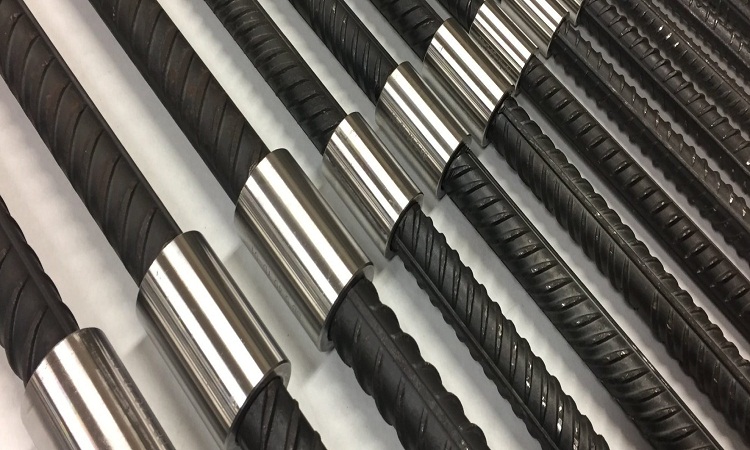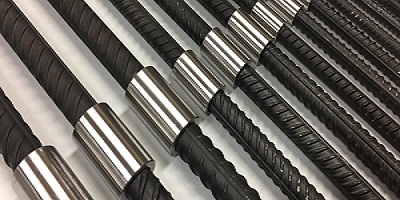Rebar coupler or mechanical splices are utilized in reinforced concrete structures to replace normal rebar lap joints. The rebar coupler is also suitable for use in reinforced concrete columns & walls. Rebar coupler consists of a piece of rebar equipped with a thread & coupler sleeve at the right end as viewed in the direction of installation. In construction joints, rebar couplers can replace all rebar pieces going through the formwork.
Rebar coupler also known as mechanical splices in the construction industry; join the lengths of two reinforcing bars together.
Types of Rebar Coupler/Mechanical Splices for Rebars
- Compression only mechanical splices/End bearing splices
- Tension and compression mechanical splices
- Mechanical lap splices or tension only splice
- Dowel bar mechanical splices
Types of Rebar Threading For Coupler
Type A Threading (Standard Splice)
Simple connection by bar rotation until full thread engagement no risk of thread mismatch no risk of cross-threading in type A threading (standard splice). Rebars shall be rotated from the joint.
Type B Threading (Position Splice)
Even when both bars cannot be turned. The coupler is engaged onto the extended thread of the connecting bar. The assembly is completed by butting the end of the bar to end & screwing back the coupler onto the first bar until full engagement.
The above pitch is been tested & compiles with the conditions of acceptance under code AC133, ACI 318, ACI 439 and IS 1786.
Things to Consider While Buying Rebar Coupler
Here are some of the important features in a rebar coupler that you must consider before buying the best rebar coupler:
Quality of Rebar Coupler
The most significant thing which you should prefer while buying a rebar coupler is its quality. As a construction expert, you are aware of the significance of product quality to complete your job more effectively. Hence, you must look to get the highest quality rebar couplers.
Better Tension Strength
You must ensure that the rebar coupler which you going to use is capable of handling better tension strength more effectively. Know about the capacity to handle your project’s capacity well and let you improve the integrity and continuity of your structure.
Durability and Reliability
You have to choose the best rebar coupler that can stand for a longer period and support your structure more effectively. As these are the best significant components in your construction structure, accordingly, never compromise on their reliability & durability.
Price
When you are going to purchase the best and most effective rebar couplers then you should look for the ones which are available at competitive prices in the market. It is because paying more for these construction components can lead you to high construction costs with ease.
Test of Rebar coupler or Mechanical Splices
- Static Tensile Test
- Slip Test
- Cyclic Tensile Test
- Low Cycle Fatigue Test
- High Cycle Fatigue Test
- Yield Strength of Steel
Advantages of Rebar Coupler
There are many advantages to using rebar couplers as given below:
Rebar Continuity
Reinforced concrete design codes of practice assume that the detailing, quality of materials, and workmanship are such that the transmission of forces from one rebar to the other is assured. However, if the bond between the concrete & the rebar is lost, as a result of concrete cracking, deterioration, poor on-site workmanship, rebar corrosion, and subsequent spalling, etc. Then the rebar splice may fail. Rebar couplers do not rely on concrete bonds and therefore they create more reliable rebar continuity.
Avoidance of Transverse Splitting Forces
Many structural concrete codes of practice recommended the use of rebar couplers as an alternative to lapping, particularly for large rebar diameters where splitting and dowel action forces can be significant. Euro code 2 states: “Generally large diameter bars shouldn’t be lapped. Exceptions include sections with a minimum dimension 1m or where the stress isn’t more than 80% of the design ultimate strength & splitting forces are higher & dowel action is greater with the utilization of large diameter bars”.
Reduction of Rebar Congestion
Lapping rebar in heavily reinforced sections can cause significant congestion, resulting in issues fixing the steel & inadequate space for the proper placement & compaction of the concrete. The utilization of rebar couplers will significant reduce congestion making the placement and compaction of the concrete easier, leading to less risk of concrete segregation due to over vibration & as a result an increase in the quality of concrete.
Safety
On-site safety during construction is paramount. The utilization of rebar couplers can contribute to increasing site safety:
- Rebar protruding through shuttering, which can be dangerous, can be removed by using couplers butted up against the shuttering or formwork, allowing the connection of the adjoining rebar after the shuttering or formwork is removed.
- On-site welding of rebar can be eliminated by joining pre-assembled cages with rebar couplers.
Ease of Construction
The safety advantages of rebar coupler do not come at the expense of construction ability, in fact, the use of rebar couplers can make on or off-site construction easier and faster as well as safer.
- Prefabricated rebar cages can be easily connected on site making on-site welding of rebar unnecessary.
- Individual concrete components & construction joints can be joined without the need to drill through shuttering.
- The utilization of couplers allows for the face of concrete elements to remain smooth during construction, making construction easier & faster.
Reduction in Steel Use
The utilization of rebar coupler reduces steel consumption & can therefore be an environmentally friendly and more sustainable option than lapping. The steel saved is equal to the lap length.
Technically Superior
Rebar coupler performs like continuous reinforcement. Independent of concrete, splicing develops strength mechanically. Therefore gives ductility in RCC structures independent of the condition of the concrete. The continuity of spliced rebar offers the superb arrangement of grounding electrical current.
Designer Friendly
In dense reinforcement members, congestion of rebar is largely reduced by using a coupler system. This helps improves concrete flow and consolidation. Rebar coupler provides greater flexibility in design options. The simplicity in detailing of reinforcement, especially in reinforcement congestion zones minimizes the reinforcement fixing errors, detailing & fixing of seismic reinforcement becomes effortless.
Quality, Cost and Time Advantages
Rebar coupler system offers quality, cost, and time-saving. No special skills or types of equipment are required for fixing rebar couplers. Simple mechanical ways in adopting mechanical splicing compared to lapping accelerate construction schedules for optimum cost and efficiency. Handling the rebar in convenient sizes saves valuable crane time. In the case of high diameter rebars, a considerable length of rebars saves making the rebar coupler system economical.
Disadvantages of Rebar Coupler
- There is a probability of misalignment in the attachment of two shafts which will create an excessive force on the coupling, shaft, and bearings, causing them to wear prematurity.
- Availability of rebar couplers in the local market is very difficult whose diameter is more than 32mm or more.
- It may create structural damage if the grade of the rebar coupler will not be equivalent to the reinforcement bars.
- Skilled laborers are required for the assembling process.


